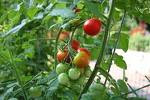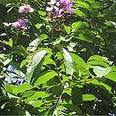The tomato was once reviled because Europeans thought that it was the “wolf peach” described by Galen in the 2nd century AD; that is what its Latin name means, lyco meaning wolf and persicum, peach. Galen was describing poison given to wolves in a wrapping that looked and presumably tasted delectable to wolves. They ate the “wolf peach” and met their demise. For this reason, when Cortez the Spanish conquistadore brought it from South America, (he had first seen it in Montezuma’s garden) it was viewed with suspicion and grown for ornamental purposes only. Its English name comes from the Spanish “tomati” first mentioned in print in 1595. It is probable that the first tomatoes were yellow as the Italian and Spanish words for them were Pomi d’oro or golden apples. The Italians were the first Europeans to use the fruit (tomatoes are fruit, and because of the seeds a berry in botanical terms) although it is unclear where they got the idea from, perhaps what is now Turkey, or the area around Lebanon.
 Perhaps the Europeans were suspicious of tomatoes because they are members of the Solanaceae family which includes belladonna or the deadly nightshade, as well as potatoes, chilli peppers and aubergines (eggplants). Although people started eating them, (the French considered them an aphrodisiac and called them Pomme d’ Amour or Love Apples) physicians warned that they caused appendicitis (because of the seeds) and cancer because they thought that the skins stuck to the intestine walls up until the end of the 18th century.
Perhaps the Europeans were suspicious of tomatoes because they are members of the Solanaceae family which includes belladonna or the deadly nightshade, as well as potatoes, chilli peppers and aubergines (eggplants). Although people started eating them, (the French considered them an aphrodisiac and called them Pomme d’ Amour or Love Apples) physicians warned that they caused appendicitis (because of the seeds) and cancer because they thought that the skins stuck to the intestine walls up until the end of the 18th century. Joseph Campbell first marketed his condensed tomato soup in 1897 and this was extremely popular, and his company went from strength to strength. Canned tomatoes are the world’s most best selling canned fruit or vegetable and you will be glad to know that lycopene, which makes them red, and gives them their cancer fighting abilities is increased in potency when heated during the manufacturing of tomato products, including ketchup (but the best is organic ketchup), tinned tomatoes, tomato paste, passata and puree.
 Tomatoes are rich in vitamins C and A, both of which have potent antioxidant properties and are immensely beneficial for our health. They also contain vitamins E, K and the B-complex vitamins as well as the minerals calcium, iron, magnesium, phosphorous, potassium, zinc, copper, manganese, 17 amino acids glucose and fructose, molybdenum and chromium.
Tomatoes are rich in vitamins C and A, both of which have potent antioxidant properties and are immensely beneficial for our health. They also contain vitamins E, K and the B-complex vitamins as well as the minerals calcium, iron, magnesium, phosphorous, potassium, zinc, copper, manganese, 17 amino acids glucose and fructose, molybdenum and chromium. Recent medical research has shown that tomatoes when eaten with broccoli, together fight cancer very effectively. Professor John Erdman of the University of Illinois said “When tomatoes and broccoli are eaten together, we see an additive effect. We think that it’s because the different bioactive compounds in each food work on different anti-cancer pathways.” If you have 2 pints of green tea in your daily diet and eat tomatoes these are also thought to lower the risk of prostate cancer.
Lycopene would seem to be the anti-cancer component in tomatoes and other foods which have a high lycopene content are apricots, pink grapefruit, watermelon, papaya and guava (amroot).
 Drinking tomato juice may reduce the risk of blood clots and is a natural anti-inflammatory so good for osteoporosis, arthritis and other inflammatory diseases. However you should choose a brand that has a low sodium content.
Drinking tomato juice may reduce the risk of blood clots and is a natural anti-inflammatory so good for osteoporosis, arthritis and other inflammatory diseases. However you should choose a brand that has a low sodium content. In January 2011 a Japanese researcher, Dr. Teruo Kawanda from the University of Tokyo said “…the tomato allows people to easily manage the onset of dyslipidemia through their diets” thus reducing the risk of cardio-vascular diseases.
Tomatoes can also help reduce the risks of thrombosis and Alzheimer’s disease, according to research.
Tomatoes are a staple of the Mediterranean diet and there’s nothing quite like an Italian plum tomato or a Greek ‘beef’ tomato in sauces or stuffed, or just a huge tomato sliced and made into a salad with black olives, cucumber and feta cheese drizzled with olive oil and sprinkled with basil and/or oregano. In 2010 the Italians faced a minor disaster when their staple tomato crop suffered because of a heat wave.
Tomatoes may be red, yellow, orange, purple, green or even brown. However you shouldn’t eat green tomatoes raw, only when cooked or pickled.
You can sun dry your own tomatoes as they are delicious in salads and perk them up in winter in a rocket salad. You should reckon on 10 tomatoes producing an ounce of sun dried ones. Slice the tomatoes in half and lay them on wire netting, raised off the ground so that air can get to all sides of them. Sprinkle them lightly with salt and basil or oregano for a full-flavoured effect, the cover them with cheesecloth so that it doesn’t touch the tomatoes. This will deter insects. Leave in a sunny place to dry, but remember to take them in at night before the dew falls. The drying process will take between 4 days to 2 weeks depending on the amount of sun you get in your part of the world. When they have dried, and are crumbly, you can store them in a jar with olive oil with cut garlic and more fresh herbs if you like.
Below is a recipe for green tomatoes, which shouldn’t be rock hard. It’s a traditional Punjabi dish and really delicious.
SPICY GREEN TOMATOES
Ingredients
½ kg small green tomatoes
1tsp garlic paste (pounded garlic cloves)
1 tsp ginger paste (pounded ginger root)
1 onion, finely chopped
1 handful fresh coriander
1 handful fresh mint
salt and pepper to taste
1 tsp turmeric
1 tsp garam masala
1 cup oil
Method
Make a deep cross in each tomato but don’t cut all the way through.
Mix salt and pepper, turmeric and garam masala and then rub this mixture into the slits with a knife. Leave them to stand for ½ an hour.
Heat the oil in a pan and fry the garlic and ginger pastes until they become brown. Add the onion and cook for 3-4 minutes until it becomes soft.
Add the tomatoes to the pan, with the cut side uppermost. Put enough water in the pan so that the tomatoes are completely covered.
When the water begins to boil, cover and cook over a low heat for about ½ and hour or until only about ½ a glass of water is left in the pan.
Add the coriander and mint and cook for 2 minutes, then remove and serve with naan, roti or chapattis. It tastes superb.
This has Taste and is a Treat.









































